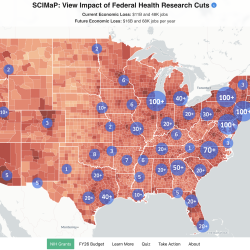Scientists Force Rethinking of Ecological Paradigm through the Power of Global Science Network
 For decades, ecologists have toiled to nail down general principles explaining why some habitats have so many more plant and animal species than others. Much of this debate is focused on the idea that the number of species is determined by the primary productivity of the habitat. Shouldn't a patch of prairie contain a different number of plant species than an arid steppe or an alpine tundra?
For decades, ecologists have toiled to nail down general principles explaining why some habitats have so many more plant and animal species than others. Much of this debate is focused on the idea that the number of species is determined by the primary productivity of the habitat. Shouldn't a patch of prairie contain a different number of plant species than an arid steppe or an alpine tundra?
Maybe not, says an international team of scientists that pooled its resources to re-evaluate the relationship between species numbers and habitat productivity. Their innovative, standardized global sampling of 48 sites on five continents yielded an unprecedented data set.
"Our study shows no clear relationship between productivity and the number of plant species in small study plots," says Utah State University plant ecologist Peter Adler.
These findings from lead author Adler and colleagues, among them University of Maryland entomologist Daniel Gruner, represent a significant advance in ecological thought, appearing in the September 23, 2011 issue of the journal Science.
"We challenged a prevailing model developed in the early 1970s by British ecologist J. Philip Grime," says Adler. "He proposed that the number of species rises then declines with increasing productivity."
Though hotly debated, this "hump-shaped" model has remained a textbook standard for nearly four decades. Existing, disparate case studies provided uneven evidence to support Grime's unimodal pattern. Inconsistencies in data collection methods further hampered efforts to distill reliable empirical evidence to support the hump-shaped model.
The team of ecologists tackled this problem as part of a distributed global research network, called the Nutrient Network. The "NutNet" was founded by a small team and driven forward by Drs. Elizabeth Borer and Eric Seabloom, now at the University of Minnesota, who secured an NSF Research Coordination Network grant to coordinate research and host annual meetings. University of Maryland graduate Dr. Eric Lind, from the Behavior, Evolution, Ecology and Systematics Ph.D. program, manages the network and its massive datasets as a postdoctoral scientist at Minnesota.
The idea for this network emerged some five years ago, out of a working group at the National Center for Ecological Analysis and Synthesis, co-organized by Gruner and collaborators Jon Shurin and Helmut Hillebrand. "The directive of this Center and of our working group was to bring together existing data in novel and innovative ways that can test big questions in ecology and raise new ones," says Gruner. "While we achieved much with our meta-analyses, we were dissatisfied with the limitations of comparing datasets from many different ecosystems, collected and presented by different investigators in many different ways over the years."
The NutNet approach is to deploy a coordinated experimental network with simple, standardized protocols at sites worldwide. According to Gruner, "with NutNet, we can replicate ecological studies in an unprecedented number of grassland habitats. We can move beyond the limitations of unique case studies, and this gives us the power to tackle long-standing, contentious questions in ecology."
Investigators have joined the network by contributing their own modest resources to run studies at research sites they know well. A member of the NutNet steering committee, Dr. Gruner runs his studies with Dr. Louie Yang at the Sagehen Creek Field Station in the Sierra Nevada range of California.
"Our work not only sheds light on this classic question, it also demonstrates the power of our network approach," Borer says. "NutNet data are poised to inform many pressing ecological questions. Similar global, grassroots collaborations could help settle other longstanding scientific debates."
"Our data emphasize the need to consider many factors to explain patterns of diversity – not just productivity alone," Adler says.
For the ecological community, he says, NutNet's current findings should spur ecologists to focus on other important factors regulating biodiversity, such as evolutionary history, disturbance and resource supply.
"It's time to remove outdated models from our textbooks and concentrate on more sophisticated approaches," Adler says. "That will improve our ability to predict the effect of environmental change on biodiversity."
Gruner concludes, "using these coordinated experimental approaches, we expect that NutNet will bear fruit for years to come."







